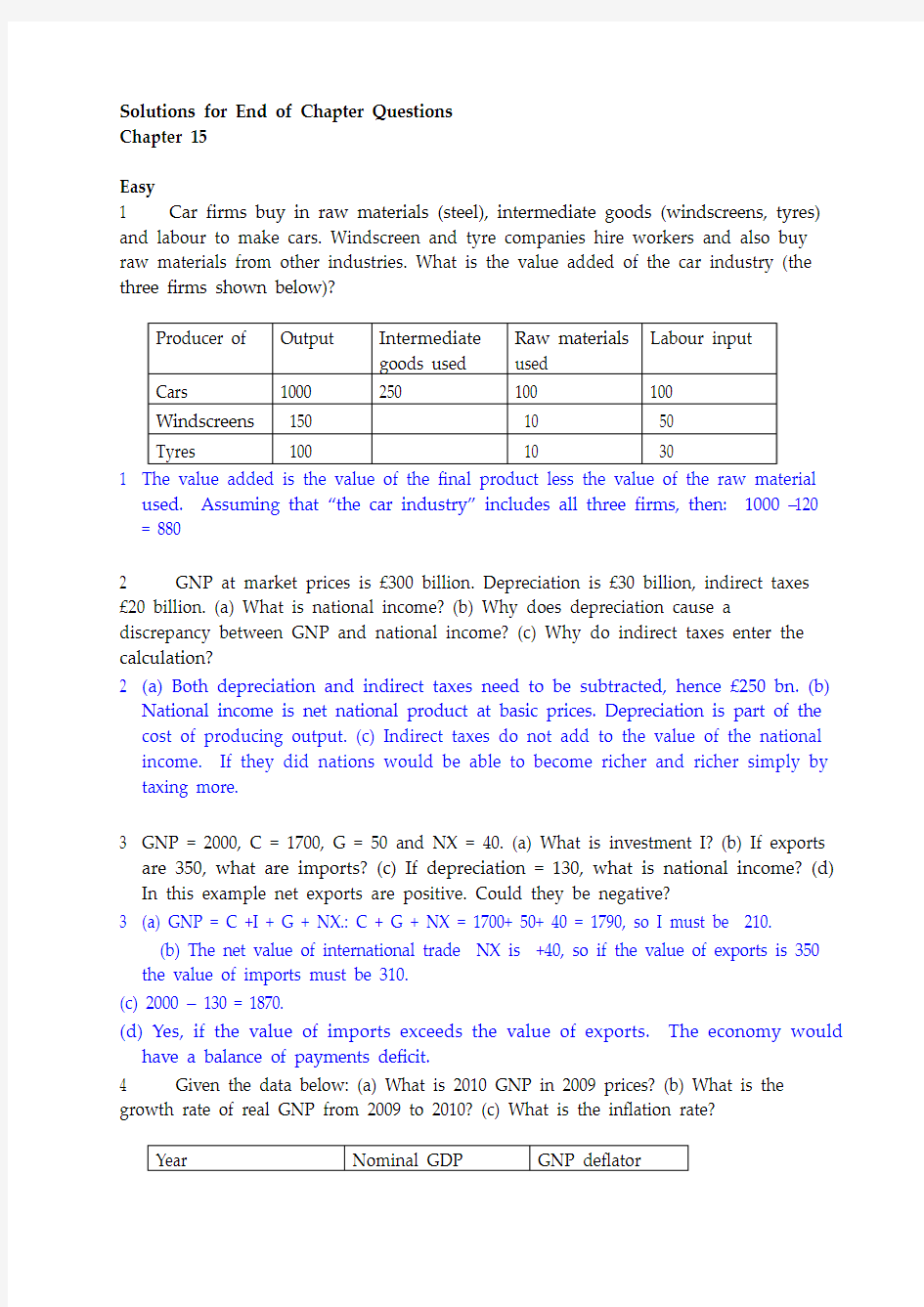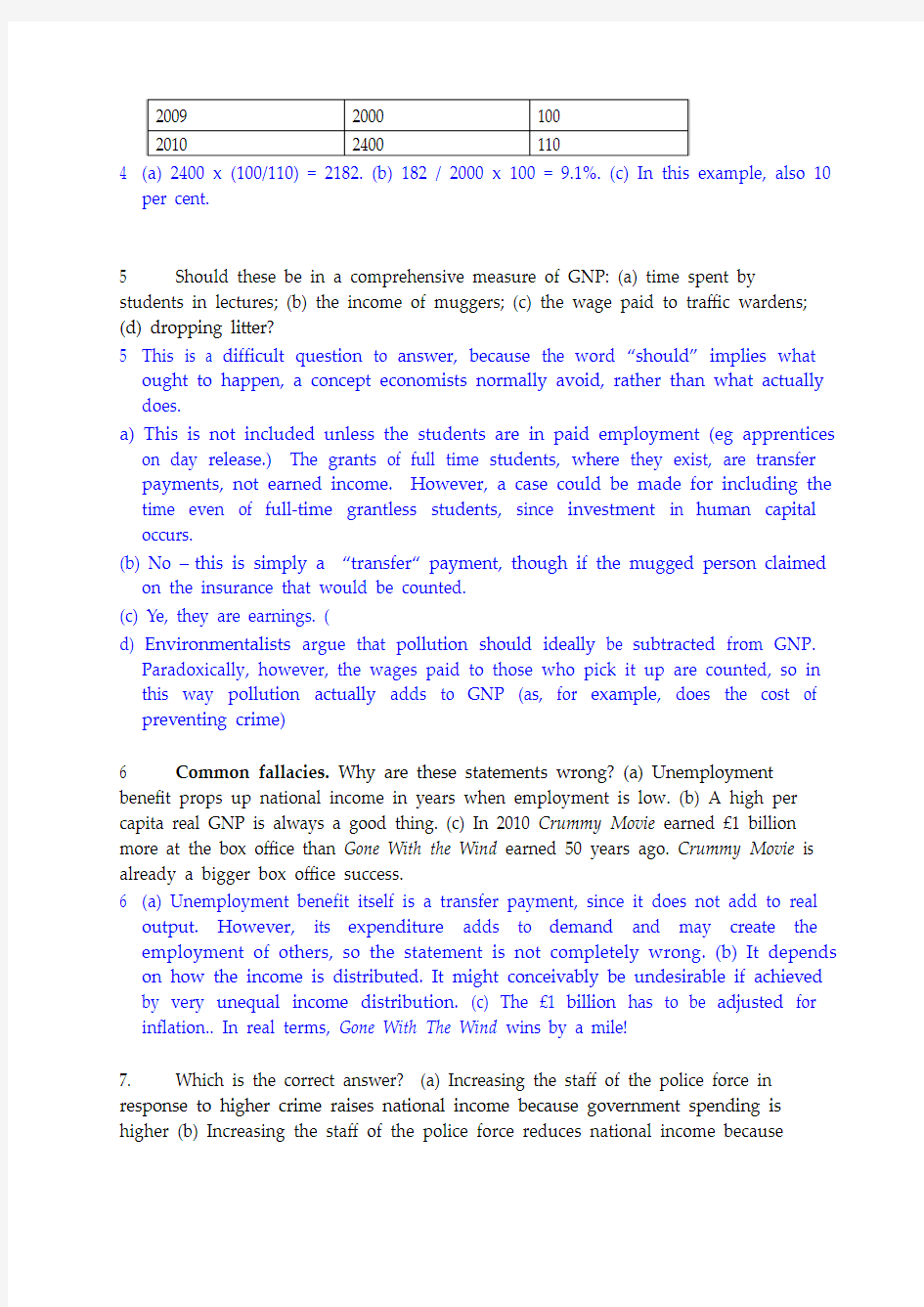

Solutions for End of Chapter Questions
Chapter 15
Easy
1 Car firms buy in raw materials (steel), intermediate goods (windscreens, tyres) and labour to make cars. Windscreen and tyre companies hire workers and also buy raw materials from other industries. What is the value added of the car industry (the three firms shown below)?
1 The value added is the value of the final product less the value of the raw material
used. Assuming that “the car industry” includes all three firms, then: 1000 – 120 = 880
2 GNP at market prices is £300 billion. Depreciation is £30 billion, indirect taxes £20 billion. (a) What is national income? (b) Why does depreciation cause a discrepancy between GNP and national income? (c) Why do indirect taxes enter the calculation?
2 (a) Both depreciation and indirect taxes need to be subtracted, hence £250 bn. (b)
National income is net national product at basic prices. Depreciation is part of the cost of producing output. (c) Indirect taxes do not add to the value of the national income. If they did nations would be able to become richer and richer simply by taxing more.
3 GNP = 2000, C = 1700, G = 50 and NX = 40. (a) What is investment I? (b) If exports
are 350, what are imports? (c) If depreciation = 130, what is national income? (d) In this example net exports are positive. Could they be negative?
3 (a) GNP = C +I + G + NX.: C + G + NX = 1700+ 50+ 40 = 1790, so I must be 210.
(b) The net value of international trade NX is +40, so if the value of exports is 350
the value of imports must be 310.
(c) 2000 – 130 = 1870.
(d) Yes, if the value of imports exceeds the value of exports. The economy would
have a balance of payments deficit.
4 Given the data below: (a) What is 2010 GNP in 2009 prices? (b) What is the growth rate of real GNP from 2009 to 2010? (c) What is the inflation rate?
4 (a) 2400 x (100/110) = 2182. (b) 182 / 2000 x 100 = 9.1%. (c) In this example, also 10
per cent.
5 Should these be in a comprehensive measure of GNP: (a) time spent by students in lectures; (b) the income of muggers; (c) the wage paid to traffic wardens;
(d) dropping litter?
5 This is a difficult question to answer, because the word “should” implies what
ought to happen, a concept economists normally avoid, rather than what actually does.
a) This is not included unless the students are in paid employment (eg apprentices
on day release.) The grants of full time students, where they exist, are transfer payments, not earned income. However, a case could be made for including the time even of full-time grantless students, since investment in human capital occurs.
(b) No –this is simply a “transfer“ payment, though if the mugged person claimed
on the insurance that would be counted.
(c) Ye, they are earnings. (
d) Environmentalists argue that pollution should ideally be subtracted from GNP.
Paradoxically, however, the wages paid to those who pick it up are counted, so in this way pollution actually adds to GNP (as, for example, does the cost of preventing crime)
6 Common fallacies. Why are these statements wrong? (a) Unemployment benefit props up national income in years when employment is low. (b) A high per capita real GNP is always a good thing. (c) In 2010 Crummy Movie earned £1 billion more at the box office than Gone With the Wind earned 50 years ago. Crummy Movie is already a bigger box office success.
6 (a) Unemployment benefit itself is a transfer payment, since it does not add to real
output. However, its expenditure adds to demand and may create the employment of others, so the statement is not completely wrong. (b) It depends on how the income is distributed. It might conceivably be undesirable if achieved by very unequal income distribution. (c) The £1 billion has to be adjusted for inflation.. In real terms, Gone With The Wind wins by a mile!
7. Which is the correct answer? (a) Increasing the staff of the police force in response to higher crime raises national income because government spending is higher (b) Increasing the staff of the police force reduces national income because
society is having to waste resources tackling crime (c) There is no effect on national income because the benefit of more police is offset by the cost of more crime
7 (a) is correct because government expenditure in wages (eg of teachers, soldiers,
cleaners, and, as in this question, the police) adds to the national income. The arguments put forwards in b) and c) are really couched in terms of national well-being or welfare (which may be more important than national income.).
Medium
8 Suppose a country is unable to borrow from abroad and must always equate the value of its exports and imports. If the private sector is saving a lot more than it is investing, is the government in surplus or deficit? Why?
8 Since total leakages equal total injections, and since exports equal imports, this
means that, if the economy is in equilibrium, remaining injections (investment + government spending) must be equal to remaining leakages (saving + taxes).
Hence, if saving exceeds investment, government spending must exceed taxes.
The private sector surplus is offset by the government deficit.
9 It is the year 2060. Nation states have been abolished and there is a world government whose spending is entirely financed by income tax. Redraw Figure 15.6 explaining how you have changed it.
Figure 15.6 Summarizing the National Accounts
[GRAPHIC ARTIST – PLEASE REDRAW THIRD COLUMN SO THAT THE DEEP ORANGE PART FOR NET PROPERTY INCOME FROM ABROAD IS THE SAME
IN COLUMNS TWO AND THREE, but different from depreciation in column 4]
9 Reduce all column heights by eliminating net property income from abroad (at
least until we trade with other planets), and eliminate indirect taxes so that last two columns are same height as NNP at market prices
10 The world government now publishes world economic accounts that estimate not merely depreciation of the stock of physical capital but also of the stock of environmental capital. (a) If pollution and climate change are causing adverse effects, how does your new diagram on world income and output differ from that in question 9? (b) Suppose environmental depreciation was initially $500bn and the world government spends $100bn on pollution control with the consequence that environment depreciation is now only $300bn. How is your diagram now affected?
10 (a) Depreciation (environmental + capital) is now bigger, reducing NNP in
column 4. The heights of columns 5 and 6 fall by similar amount. (b) The spending on G raises GNP in columns 1-3. by $100bn, and reduces depreciation in column 4. NNP rises for both reasons. Columns 5 and 6 increase by a similar amount.
11 You are head of the Leisure Commission that has to recommend to the government how to include the value of leisure in GDP. How do you come up with an estimate?
11 The place to start is that by taking leisure people reveal that this is at least as
valuable to them as working more, provided that have that choice in the first place. For all such people, you would have to decide how many hours a day are the fixed costs of being alive – for sleeping, eating, washing etc – and hence how many hours could potentially be allocated between work and leisure. Knowing something about national wage rates and hours of work, you could have a stab at valuing total leisure hours.
In theory at least decisions between work and leisure are made, like so many economic decisions, at the margin. Thus in many industries, “overtime” is paid at
a higher rate than normal in order to make work more attractive than leisure. A
person working a 35 hour week would probably value an extra hour’s leisure less than someone working a 45 hour week.
Some other complications: (a) all the people who don’t have the choice of working or not –the young, the sick, those caught in a poverty trap (b) the distinction between those working but choosing some leisure and those on benefit schemes you simultaneously get money and leisure (c) how to treat parents who stay at home to look after children. Even so, it would be possible to make a guess.
12The price of a new television has remained roughly constant for the last 30 years. What does this show?
12 Disentangle some things (a) the nominal price has been constant therefore the
real price has fallen a lot (b) quality has improved hugely over the period. To explain both of these simultaneously, there must have been a lot of technical progress. Deciding how to revalue goods because of their superior quality is just one of the headaches of a statistician working on the national accounts.
13 Suppose the injections to the circular flow (investment I, government spending G, and exports X) do not depend on the current level of national output Y. In contrast, suppose leakages increase as output increases. Specifically, saving S = 0.1Y, imports Z = 0.4Y, and taxes T = 0.5Y. (a) If total injections equal 100, what is the value of national output? (b) If G = 40, is the government budget (G-T) in surplus or deficit?
13 a) the multiplier is 1 (1 divided by the sum of the propensities to leak at the
margin, 0.1+0.4+0.5). hence Y= 100
b) T = 50 (half of the addition to Y) and the government deficit is therefore 10 if G =
40
Hard
14 Essay question ‘Economists are preoccupied with what they can measure. GDP is so misleading an indicator of welfare that it is almost pointless to gather statistics about it, either for international comparison across countries or to assess how well particular governments are doing.’ How useful is GDP? Could we easily have a better indicator?
The statement in inverted commas is wrong – it is far from pointless to try to measure GDP, provided the result is used with an awareness to its limitations. There are many suggestions for constructing a better measure, but none is easy.
In planning your essay try to break your answer down into several sections. One suggestion would be:
Acknowledged limitations of GDP
Suggestions for improving GDP
Attempts at constructing a better measure.
Under these headings you should explain and discuss issues such as : Acknowledged limitations of GDP
?Measure income per head, not just total income
?Does not give information about income distribution/equality
?Ignores untraded goods and services (eg housework, voluntary work, own produce, subsistence farming in developing countries, exchanges of services.) ?Unreported output (the informal or “back pocket” economy, formerly known as the “black” economy, but this term is no longer acceptable ))
?Use of a common international currency for international comparisons (purchasing power parity rate rather than market rate)
Suggestions for improving GDP
?Subtracting for resource use
?Subtracting for “bads” such as pollution and congestion
Attempts at constructing a better measure.
The United Nations already uses a Human Development Index, HDI, which, in addition to GDP includes life expectancy at birth, infant mortality rate, percentage of children in school, and level of adult literacy. The HDI is particularly useful for comparing developing countries.
Suggestions for an index of Human Welfare or Well-being, in addition to GDP, include such things as:
?Leisure and working hours
?Measure of equality (the Gini coefficient)
?Stability of marriages, partnerships
?Age of retirement
?Incidence of mental illness, suicide.
?Percentage of young people in higher education.
?Access to theatres, museums, libraries, etc.
“Happiness” itself is difficult to measure, but some of the above are easily quantifiable.